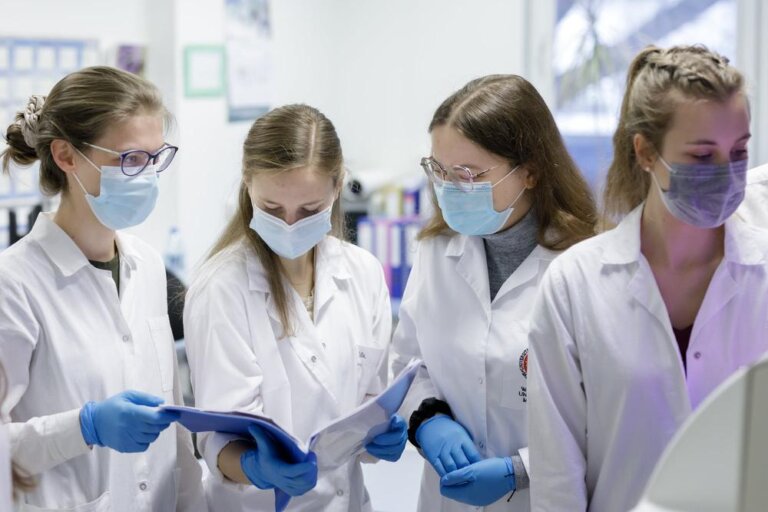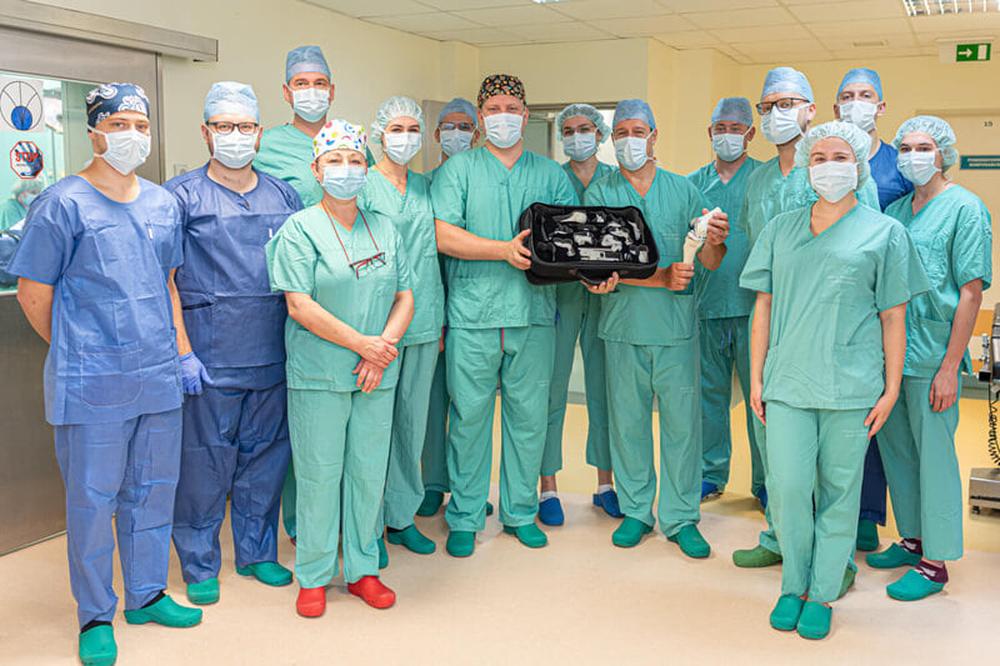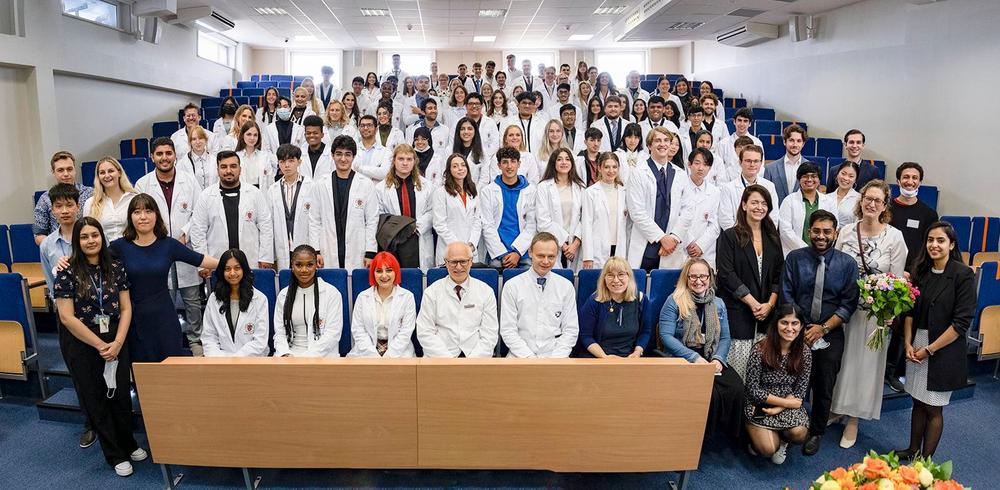
Located in: Poland
































Warsaw Medical University was established in 1809. The Polish medical university offers English-taught medical courses aimed at high school leavers. The programme is adapted according to the Directive of the European Parliament 2005/36/EC and covers 5,700 hours overall.
A regular MD (Doctor of Medicine) programme is 6 years long for high school leavers. The programme also offers students the opportunity to do USMLE part 1 in year three and USMLE part 2 in year six.
For students who wish to study medicine in Europe in English, the Medical University of Warsaw established the English Division of the Second Faculty of Medicine in 1993. There’s no graduate entry, but university transfers are possible.
The Medical University of Warsaw offers a preparation course for international students in the English language.
The Pharmacy Programme represents a full-time five-year study course.
The Dentistry Faculty at the Medical University of Warsaw is believed to be one of the best places in Poland to study dentistry.
Medical University of Warsaw’s address is 61 Żwirki I Wigury St., 02-091 Warsaw, Poland.




With over 800 international students, the Medical University in Warsaw must be offering more than a world-class education. In fact, the university hosts over 200 specialised research clubs and over a dozen organisations and associations representing various interests in academics, arts, and sports.
The opportunities for research at the Medical University in Warsaw are truly amazing. Resident scientists study exciting fields such as longevity, Covid-19, takotsubo syndrome, diabetes, and skin microbiota. These are just a few of the ongoing projects, and aspiring doctors with a love for science could certainly find a niche to leave their mark.
Meanwhile, the School of Physical Education and Sport and the Sports and Rehabilitation Center are taking care of students’ physical recreation. Athletic aficionados can enjoy basketball, volleyball, football, handball, and tennis. They can also try the Olympic-sized swimming pool or the martial arts hall. The cherry on the cake? There is a dance hall!
Speaking of dancing, it is not the only performing art represented on campus. Gifted students can join the university choir, the chamber orchestra, or the “Magic” theatre. Artistic talent is both praised and nurtured at MUW.
Finally, the university provides a wide range of gastronomic facilities on the campuses, where students can nourish their bodies and socialise with their colleagues.
All of the above are only campus opportunities. As far as leisure goes, Warsaw has so much more to offer to international students.
The tuition fee for medicine and dentistry is per year, and living costs are about - per month. The pre-med programme fee is .
The tuition fees for pharmacy are as follows:


Open for applications: early March – mid-May.
Students who wish to be admitted into the medical programme must have passing grades in Biology, Chemistry and Physics or Maths in their high-school leaving certificate/diploma. Medlink Students can still get admission even if they did not study all of the above subjects. Students from non-English speaking countries must have a good score in an English language test such as IELTS or TOEFL. University transfers are tough but can be arranged by us.
The admission fee is around .
Students must sit 100 multiple-choice questions on Biology, Chemistry and Physics unless they have sat the BMAT, MCAT, GAMSAT, or UKCAT exam.
Students who do not meet the entry requirements can get admitted into the foundation year with the help of Medlink Students and then into the first year of the Medicine programme.


The competition to gain admission to the Medical University of Warsaw can be quite fierce, and navigating the application process alone can feel overwhelming and challenging. The university has a comprehensive set of application requirements and legal procedures that must be met. This includes the submission of specific documents, which need to be translated, notarised, and legalised. Failing to fulfil these requirements will result in the rejection of your application. However, you don't have to face this task alone. Our team of admissions experts, widely renowned as the best in Europe, specialises in managing all legal aspects down to the finest details. We have also built a strong partnership with the Medical University of Warsaw and possess extensive knowledge of the entire application process and entrance exam. Throughout the process, we will diligently handle your application, ensuring it meets the highest standards and significantly improves your chances of being accepted into this prestigious university. Moreover, we will provide you with exceptional study materials that comprehensively prepare you for the demanding entrance exam, making it much more manageable to overcome. By choosing Medlink Students, you can avoid the stress of the application process and focus on preparing for the entry examination.
You will get an international degree in medicine when you complete your studies successfully.
The Medical University of Warsaw is recognised by the GMC. To be accepted, the GMC’s requirements are: you will need to have graduated successfully in a course that contained at least 5,500 hours and lasted at least three years.
Polish medical universities meet the criteria for acceptance into the GMC.
The university offers students from the English Division 50 rooms in the Students` dormitory. Its address is Karolkowa 84, 01-193 Warsaw.
Prices per semester per room are as follows:
A student dorm room consists of:
On each floor, you can find a kitchen equipped with an electric stove with an oven, microwave and several sinks.
Common areas across campus that students can use include:
If you’d prefer to live by yourself or with a roommate outside of the dormitory, the price of rent for an apartment is between - per month. This depends on how close you will be to the city centre.
When it comes to leisure activities, Warsaw has plenty to offer. For cultural events, you can choose from numerous cinemas, theatres, concert halls, clubs, galleries and many more.
If sightseeing is your thing, Warsaw has an abundance of churches, castles, museums and many other attractions. Warsaw isn’t short of sports and outdoor activities too.


Situated on the Vistula River, Warsaw has grown from a fishing village to the modern capital and largest city of Poland. Such prosperity would be impossible without the enterprising Warsawians and their mythic guardian, the Warsaw Mermaid. Visitors will quickly learn that it is the symbol of the city, and it signifies the importance of the Vistula to the city.
Residents have set up numerous attractions and leisure areas along the river. Cyclists and pedestrians can stroll along the coasts on both banks or they can relax on the sandy beaches and enjoy the scenic vistas of the Vistula. Fans of water sports or boat rides would not be disappointed either; there are plenty of opportunities for both.
Moving downstream, adventurous doctors explore the Kampinowski National Park, which is a protected area just 10km from the town. It is an excellent spot to recharge from the city rhythm and refresh in nature.
Back in the city, students love the local music festivals and events, the most famous being the Orange Warsaw Festival and the Wianki. The latter is the cultural heart of Warsaw. It takes place during Midsummer Eve, and people celebrate it with concerts, speeches, and fireworks.
Fans of more sophisticated cultural pleasures can enjoy several operas, theatres and museums on Warsaw's territory. Since most of them are located in the city centre and old town, aspiring doctors may visit many of the landmarks along their way. Instead of using a map, they can just follow the panorama of church and palace spires to guide them.
Usually, the winter semester starts at the beginning of October and has a duration of 15 weeks. Exam sessions are from the end of January until mid-February.
The summer semester lasts 15 weeks, starting mid-February till mid-June, immediately followed by the exam session.










The university is in Warsaw, Poland. The city lies on the Vistula river in the east-cental parts of the country. The university’s address is 61 Żwirki I Wigury St., 02-091 Warsaw, Poland.
Yes. Transfers are possible for medical students.
No. Fast track medicine is not possible at this medical school.
Tuition fees are as follows:
Medicine:
1st year -
2nd-6th -
Dentistry:
Pharmacy:
1st year -
2nd year -
3rd - 5th -
6th year -
The university's medical graduates get international recognition of their degrees. The World Health Organisation recognises it through its World Directory of Medical Schools. In addition, the UK General Medical Council also recognises the university.
Yes, there are several English-taught programmes at the university. You can study general medicine, dentistry, and pharmacy in English.
Yes. As of 2022, the university has over 200 graduates registered with the UK General Medical Council.
Yes there is. Students can take a single exam covering their high school knowledge in Biology, Chemistry, and Physics. Alternatively, they can use their scores from the BMAT, MCAT, GAMSAT, or UKCAT exams.
The university uses students’ secondary school grades in Biology, Chemistry, and Maths/Physics as a ranking criterion. In addition, students should pass the medical school’s entry examination or the BMAT, MCAT, GAMSAT, or UKCAT exams.
The school year starts at the beginning of October.
The application deadline is on the 30th of June.
*For a smooth application process, confirm program intake details with your advisor in advance.
With more than 200 years of history, the Medical University of Warsaw has good traditions of academic excellence. The hundreds of international students are a good proof of the latter. In addition, they benefit from exciting extracurricular and leisure activities organised by the university.
Students have access to a student dormitory with modern amenities, providing comfortable and convenient living conditions close to campus.
The academic staff at the Medical University of Warsaw is nationally and internationally recognized for their expertise in medical research and practice. Most of the faculty members hold positions such as National Medical Consultants, contributing to the high-quality education provided.